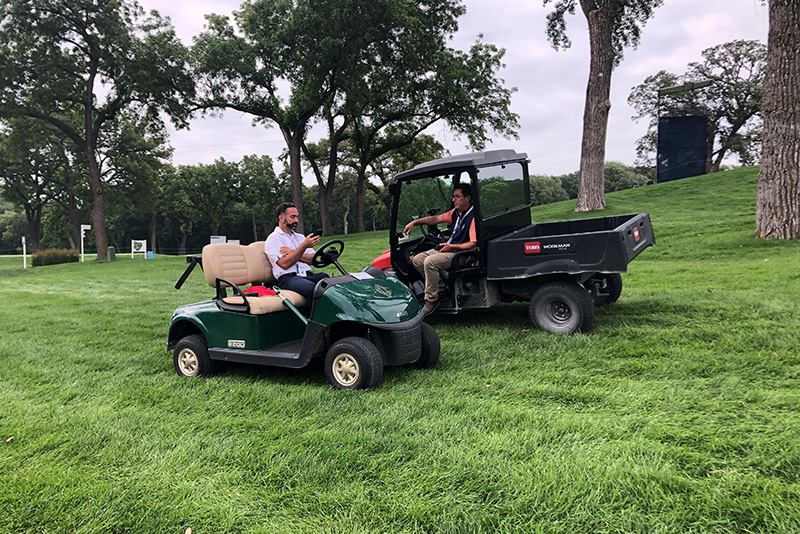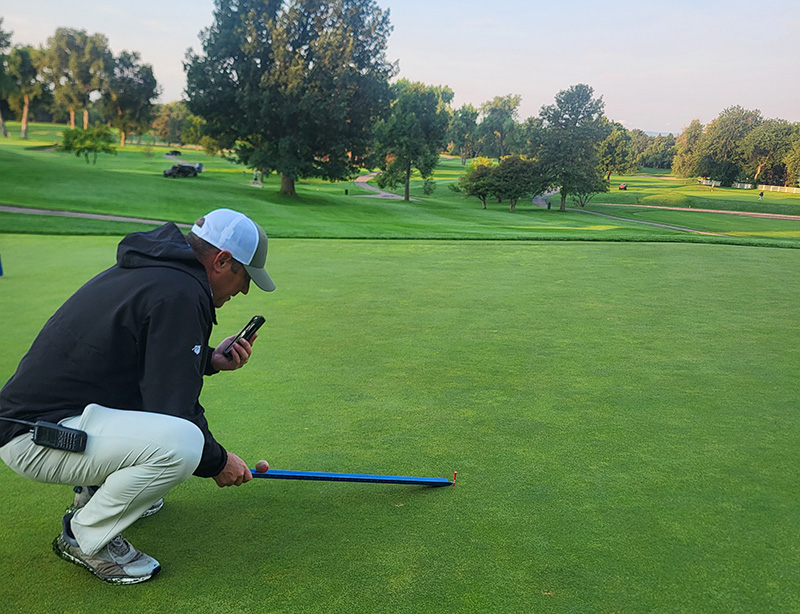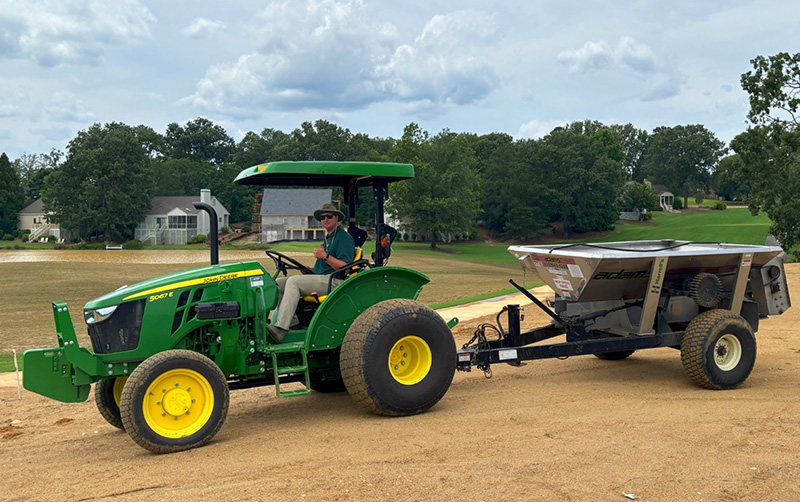
Zach Nicoludis, regional director of the Central Region for the USGA Green Section’s Course Consulting Service, talks with Eric McPherson, CGCS, and general manager of Omaha (Neb.) Country Club during a consulting visit. Photo courtesy of Eric McPherson
Editor’s note: The following article was supplied by the USGA All product claims, research cited and other information is directly from the company.
The Midwest did its best impersonation of the South this past summer, with hot and humid weather giving way to heavy afternoon downpours, leading only to hotter and even more humid conditions. Unfortunately, the severe weather caused many restless nights for golf course superintendents.
“It’s a helpless position to be in,” says Zach Nicoludis, the regional director of the Central Region for the USGA Green Section’s Course Consulting Service. Nicoludis should know, having spent four years as the superintendent of the South Course at Wilmington (Del.) Country Club before joining the Green Section in 2016.
Taking care of turf in the ever-challenging conditions of the mid-Atlantic, Nicoludis became well-versed in managing golf courses under summer stress. The experience he has gained over the past nine years as a USGA agronomist has made him well equipped to support superintendents as a peer who can relate to the agronomic challenges they experience.
“Nobody wants the golf course to be as good as it can be more than the superintendent,” says Nicoludis, who’s based in Columbus, Ohio, and conducts on-site visits as well as educational outreach throughout the Central Region. “But many of the challenges they face are outside of their control, whether they’re weather related or expectation related.”
That’s where the USGA Green Section comes in. It has provided on-site course consulting to courses nationwide for more than 75 years. The 14-member staff offers guidance to help superintendents fine-tune management practices. Agronomists conduct half-day and full-day visits as well as extensive follow-up through written reports and personal contact.
There are several reasons why superintendents and course leadership contact the Green Section, but one of the most common is for what Nicoludis calls an “agronomic checkup.” Many courses use the Course Consulting Service on an annual basis to help meet their site-specific goals, build consensus and solve unique challenges. Courses may also call on the Green Section’s services to consult on a specific project such as a bunker or greens renovation.

Josh Hester, GCSAA Class A director of grounds at Cherry Hills Country Club in Cherry Hills Village, Colo., tests green speed. Photo courtesy of Josh Hester
Experience and empathy
While most superintendents don’t have the time to regularly visit other courses, a Green Section agronomist might see five or more courses a week, sometimes in different states. The reality is that agronomists see a lot and gather abundant information, increasing their agronomic knowledge.
“I could visit a public facility one day, and the next day it could be new construction. And the day after that it could be a private country club,” says Chris Neff, an agronomist for the Green Section’s East Region. Neff is based in Bluffton, S.C., and covers the Carolinas, Georgia and Florida.
“Every day is different,” Nicoludis adds. “We visit multiple courses throughout the year. Every challenge can be different, but that’s what keeps it interesting.”
The fact that they work for the USGA, which is held in high regard by many superintendents, is reassurance that they will provide worthwhile advice according to Ross Niewola, who joined the Green Section as an agronomist in the West Region in 2024 and is based in Portland, Oregon. But Niewola also likes to remind green committees, owners and others that their superintendents are experts in agronomy, even if they need assistance or advice from USGA agronomists.
“We want to help superintendents move the needle. That’s what we’re here to do,” Niewola says.
As a former superintendent, Nicoludis knows what it’s like to occasionally lose some grass on the golf course. He also has experience navigating the politics within venues, whether with golfers, green committees, owners or others.
“I understand what those stresses and pressures are like,” he says.
Neff is also a former superintendent, including at Wexford Golf Club in Hilton Head, South Carolina, where he served as the director of greens and grounds. Neff says the superintendents he consults with are happy to hear he once walked in their shoes.
“Knowing that I’ve been there before, they’re not afraid to discuss issues with me,” he says.
Sometimes, the person who initiates a visit from a Green Section agronomist might not be the course’s superintendent. But Neff says the superintendent is the first person he contacts after speaking to that initial person, whether it’s a green chairperson, general manager, owner or someone else. “I always ask the person who contacts me if the superintendent knows whether I’m being contacted,” he says.
Neff’s goal is to put everyone at ease to set the tone for a productive meeting. And when the in-person meeting is over, he tells the superintendent and others to contact him with any questions. “It’s about building up trust and rapport,” he adds.
Niewola worked 16 years in golf course maintenance at numerous facilities across the country, including eight years as a superintendent, before joining the Green Section. Niewola understands the unique challenges of managing golf courses with various resources in different regions and dealing with different types of ownership or membership. His unique experiences have equipped him to help superintendents and their golf courses meet their unique goals.
Like Neff, if Niewola receives a call from anyone other than the superintendent to set up a visit, one of the first questions he asks that person is if the superintendent is aware that they contacted him. “If not, then the superintendent needs to be aware, and I need to set up a meeting with that person,” Niewola says. “And I ask the superintendent, ‘How can I help?’”
If superintendents are initially guarded about the information they want to share with him, Niewola says he understands.
“I expect that. I’ve been on the other side,” he adds. “I’m coming in from the outside and trying to provide new information. If I presume to know absolutely everything during a visit, that would be narcissistic and not very helpful to the facility.”
Nicoludis stresses the importance of being honest with everyone involved in a meeting and keeping everyone on the same page.
“Sometimes there can be difficult conversations. It’s the reality of the business we work in,” he says. “But a valuable skillset our Green Section agronomists have is how to navigate the more difficult conversations. We get everyone’s input — the superintendent, the head pro, the general manager, the green committee and others. We do what we need to do to find a solution for the course.”
Eric McPherson, CGCS, and general manager of Omaha (Neb.) Country Club, has consulted with Nicoludis and other USGA agronomists for several years and likes that they “don’t sugarcoat things.”
“They’ll be blunt and honest with you, and sometimes superintendents need that. I know I do,” McPherson says. “I appreciate their honesty and candor.”
McPherson has been at Omaha since 2011. The club hosted the U.S. Senior Open in 2013 and 2021. McPherson met Nicoludis during preparations for the 2021 championship, and Nicoludis later became the club’s consulting USGA agronomist.
USGA agronomists can see superintendents heading off a proverbial agronomic cliff and stop them before they do, McPherson says. “I want conditions to be great, but I don’t want to teeter to close to the edge,” he adds.
USGA agronomists also act as strong mediators between superintendents, green committees, general managers, owners, pros and other management staff, McPherson says.
“They do a nice job of helping everybody understand everyone else’s point of view,” he adds. “They certainly have the agronomy team’s back.”
McPherson was first introduced to the USGA Green Section when he served as an assistant superintendent at Congressional Country Club in Bethesda, Maryland. The late Stanley Zontek, director of the USGA Green Section’s mid-Atlantic Region at the time, visited the course often and McPherson had a seat at the table to listen to Zontek talk agronomics.
“I was fascinated by the amount of knowledge he had,” McPherson says. “If we ever had one hiccup, he was the first person we’d call. He was a great resource.”
If USGA agronomists don’t have answers to certain problems or challenges, they will use their agronomic connections to find them, McPherson says.
While Josh Hester, GCSAA Class A director of grounds at Cherry Hills Country Club in Cherry Hills Village, Colo., often consults with superintendents to “bounce ideas off each other,” he says the vast knowledge Green Section agronomists accumulate by visiting numerous courses is valued by superintendents who utilize their services.
“As a superintendent, you’re on an island much of the time, and you don’t get out to see other courses,” Hester says. “USGA agronomists see many different golf courses and the challenges other superintendents face, as well as the new technologies they’re using.”
Chris Jordan, GCSAA Class A director of golf and grounds at the Olde Eight Golf Club in Greenwood, South Carolina, recently worked with Neff during a complete renovation of the private course, formerly known as The Links at Stoney Point. Every hole on the course, which reopened this month, was redesigned to provide a new golfing experience. Jordan says he liked Neff’s direct approach, which was to provide “the good, the bad and the ugly” during the course’s grow-in.
“He wasn’t afraid to talk some sense into us regarding our approach,” says Jordan, noting that Neff was spot on with his advice, including advising Jordan to switch from grooved rollers to smooth rollers, to reduce sand topdressing, and to aerify to speed up turf growth during challenging weather conditions.

USGA Green Section agronomists work with superintendents across the country to keep courses in top condition, with recommendations tailored to specific needs. Photo courtesy of Chris Jordan
Championship support
The Green Section also provides support for on-course preparations at the 15 championships the USGA conducts annually in the U.S. Agronomists work with the host site’s golf course management team and other USGA staff before, during and after each championship to achieve the desired playing conditions for competition.
“What’s impressive to me is that the level of quality the USGA Green Section puts into the smaller championships is the same for something as big as the U.S. Open,” Niewola says. “The infrastructure for amateur championships is smaller, but we’re placing the same level of care into green speeds, hole locations and everything else as we would for an Open.”
The USGA has at least one agronomist on-site for each of the 15 championships, including three each at the men’s and women’s U.S. Opens. The services the agronomists perform are similar to the services they offer during typical course visits.
“It’s about building relationships with the superintendents and stakeholders on-site,” Nicoludis says.
Agronomists visit USGA championship sites a few years in advance to build relationships with superintendents and others. “We must have a solid working relationship with everybody involved,” Nicoludis says.
A week before the championship, during what is called “advanced week,” agronomists begin collecting agronomic data such as putting green firmness and speed. Results may reveal that the maintenance staff needs to “ramp up green maintenance from mowing to rolling” to achieve the desired speed for the championship, Nicoludis adds.
Educators, researchers and reporters
Because USGA agronomists witness so much in their travels, they are also accomplished researchers and reporters.
Green Section agronomists follow up course visits with detailed written reports that include photos. Hester says a follow-up report from the USGA “carries weight” because it’s from a highly regarded third-party source. He adds that USGA’s findings often provide “reinforcement” to his own recommendations to the Cherry Hills green committee.
During visits, Neff says he takes copious notes and plenty of photographs for his follow-up reports, which he says must be “actionable” for superintendents and others.
The Green Section also conducts turfgrass research with both our in-house research team headed up by Cole Thompson, Ph.D., as well as with university professors and scientists, Our regional agronomists also serve on research committees to support this important initiative. That research could include evaluating soil health and its impact on turf performance, investigating water conservation techniques for irrigation, and analyzing pest and disease management strategies.
In addition, agronomists each write 12 Green Section Record regional updates annually. The regional articles are often based on timely occurrences. For instance, Neff recently wrote an update about how to prevent scalping on putting greens in the Southeast because it had become such a problem. Nicoludis recently wrote an article on yellow nutsedge and false-green kyllinga control in the Central Region, reporting that excessive rainfall and high temperatures had created ideal conditions for the weeds to gain a foothold.
While they wear many hats, the common variable among all the services they provide is “communication,” Nicoludis, Neff and Niewola say. Make that “strong and thorough communication,” Nicoludis emphasizes.
‘“A huge part of what we do is just listening to superintendents and other decision-makers,” Nicoludis says. “And it’s not just during the time we spend with them on the course. We need to stay in constant communication with them afterward and remain a valuable resource for them.”
Cool Tools
The USGA Green Section is also increasing its agronomic offerings from a technological perspective. Over the past five years, the USGA has launched several innovative tools to help superintendents improve course maintenance. If superintendents are interested in learning more. During their visits, agronomists can provide an overview of the tools, including the DEACON management app, the GS3 ball and the USGA Moisture Meter.
DEACON, introduced in 2021, enables agronomists and superintendents to deliver better playing conditions and manage inputs more efficiently, according to USGA. It allows users to make data-driven decisions, leading to better management of maintenance inputs and labor.
The GS3 ball, introduced in 2023, was originally conceived by the Green Section for the U.S. Open and other USGA championships. The ball is engineered to provide superintendents with actionable data. With more than 15,000 data points, the ball measures green speed, smoothness, trueness, and firmness. The easy-to-use USGA Moisture Meter offers superintendents precise and consistent data regarding soil moisture, salinity and temperature. The data instantly uploads into the DEACON platform, creating a digital record that can be used to more efficiently manage water usage, plant health and golf course playability.
All three tools can be used in unison to gain a better understanding of surface playability. Nicoludis says the three tools address putting-green performance metrics, including smoothness, trueness, firmness and speed. With help from agronomists, superintendents can then quantify different aspects of green performance and benchmark maintenance practices against them.
“There’s a better understanding of whether superintendents need to roll greens, double cut them, or single cut and roll them,” Nicoludis explains. “When you can have all that data in one spot, it just makes it easier.”
Niewola says the tools allow superintendents to understand how their watering practices impact green firmness and whether practices like hand watering should be increased. He adds that many superintendents have given a thumbs up to the technology and that USGA is “just scratching the surface” with its potential.
Hester says he’s impressed with the USGA’s recent introduction of organic matter testing, which comprises a consistent set of sampling and analysis recommendations. Green Section agronomists have sampled over 300 putting greens at over 500 course the past four growing seasons and have built a strong database for courses to compare organic values. By using a consistent sampling and analysis method, course superintendents and agronomic consultants can compare values across courses and turfgrass species.
“It’s a great baseline for us to build off and to make sure we’re on the right track,” Hester says.
Lawrence Aylward is a freelance writer from Medina, Ohio, who has covered the golf course maintenance industry for 26 years.